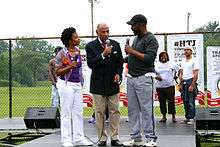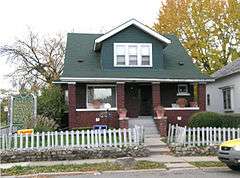History of African Americans in Detroit
| Part of a series on |
| Ethnicity in Metro Detroit |
|---|
In 2002, within the city of Detroit there were 771,966 black residents, making up 81.2% of the its population.[1] That year it was also, out of all of the U.S. cities with 100,000 or more people, the city with the second highest percentage of black people.[2] Southfield had a black population 42,259, and Pontiac 31,416. In 2002 the Michigan city with the highest percentage of black residents was Highland Park, with 93% of its population being black.[1] For the 2010 census, African Americans made up 22.8% of total city and metropolitan area population in Wayne, Oakland, and Macomb Counties.
History of African-American settlement
Before World War I, Detroit had about 4,000 black people, 1% of its population. The first major period of black growth occurred from 1910 to and 1930.[1] At the time, most blacks lived in communities made up of other racial groups.[3] Due to the war effort, employers wanted employees to fill labor jobs. Many African Americans migrated from the Southern United States to Detroit to work as part of the first Great Migration. The black population, in 1910-1930, increased from under 6,000 to over 120,000. By 1920, of Michigan's black population, 87% was born outside of the state, and most of those born out-of-state came from the U.S. South.[4] Many black "ghettoes" in Metro Detroit formed as the black population increased. T. J. Sugrue, author of The Origins of the Urban Crisis: Race and Inequality in Postwar Detroit, wrote that the first racial divisions between Whites and Blacks occurred during that Great Migration.[3]
In 1912 the National Association for the Advancement of Colored People (NAACP) founded a Detroit chapter. The Detroit Urban League was founded in 1916. Both organizations used the support of black churches. Steve Babson, author of Working Detroit: The Making of a Union Town, wrote that in the early 20th Century the black population "was relatively behind the middle-class leadership" of the NAACP and the Urban League.[5] Around the 1920s and 1930s black people working in Henry Ford's factories settled in Inkster because they did not want to commute from Detroit and they were not allowed to live in Dearborn.[6] In 1925 the State of Michigan charged Ossian Sweet with murder after he used a shotgun to kill a White man who was part of a mob trying to force him to leave his newly purchased house, located in a mostly White neighborhood. Sweet was acquitted of his charges.[7]
During the Great Depression the population stagnated.[1] The black population growth continued at the smallest rate since 1910.[4] The black population grew again during the post-World War II period.[1] In the period from 1940 to 1950, over 66% of the black population in Detroit was born outside of the area, with most of them born in the U.S. South.[8]
According to columnist Keith Richburg, in the 1960s there was a social divide between black people originating from Alabama and those originating from South Carolina; they lived east and west of Woodward Avenue, respectively; those from South Carolina took efforts to appear more prim and proper and saw those from Alabama as being lower class. Woodward described the divide as "more psychological than geographic".[9]
From 1950 to 1970 de facto racial segregation in the Metro Detroit area increased as White people moved to suburbs. In that period black growth in the suburbs averaged at 2.7% while in previous decades it was at 5%.[8] Black people began to suburbanize in the 1970s.[1] In 1970 Detroit and six other municipalities, Ecorse, Highland Park, Inkster, Pontiac, River Rouge, and Royal Oak Township, had higher than average black populations. The six suburban municipalities with higher than average black populations had 78.5% of the suburban black people in the tri-county area.[10] During the suburbanization period 1970-2000 many middle class blacks left Detroit, with many going to Southfield.[11] Throughout the period 1970 to 2000 the black suburban population was 34% of the total suburban growth. Several other suburbs had increases in their black populations. By 2000 the six suburban municipalities which had 78.5% of the tri-county area's suburban blacks in 1970 had 34% of the tri-county suburban blacks in 2000.[10] From 1990 to 2000 the increase of black people in the suburbs was almost half of the total population growth in the suburbs, and the decade 1990-2000 had the largest numeric increase of black people in the Detroit suburbs of all of the decades in the 20th Century. From 1990 to 2000 the number of black people in Detroit decreased for the first time in modern history while the percentage of black people in Detroit increased from 76% to 82%.[12] As of 2002, 90% of the black population in Wayne, Macomb, and Oakland counties resided in Detroit, Highland Park, Inkster, Pontiac, and/or Southfield.[2]
By 2011 black suburbanization had increased in scale, affecting a wider group of Metro Detroit suburbs than it had previously.[11] In the decade from 1990 to 2000 the black population in Southfield increased by over 20,000 people.[1] By 2011 black suburbanization had increased in scale, affecting a wider group of Metro Detroit suburbs than it had previously. Southfield was 70% black in 2010.[11] In 2010 9% of Macomb County's population was now black,[13] and the black population in Warren from 2000 to 2010 increased from 4,000 to 18,000.[14] From 2000 to 2010 Detroit lost around 200,000 people, showing that the black flight from Detroit was accelerating.[11] The housing market in Metro Detroit declined during the Great Recession, allowing black people to take houses in suburbs that became affordable. In this scenario many White suburbanites were unable to leave their houses, and therefore integrated with black people. Mark Binelli, author of Detroit City is the Place to Be, wrote that "In a funny way, the recession had helped this integration along."[13] An increase of Detroit residents lead to friction between Suburbanites and ex-Detroiters. Like in Southfield, between established middle class (usually blacks) and newly arrived ex-Detroiters (of any ethnicity).[13]
Institutions
Media
The Michigan Chronicle and the The Michigan FrontPage, both owned by the company Real Times, serve the African-American community.
Recreation

The "Hotter than July" annual LGBT festival is held in the park Palmer Park; the festival states that it caters to the "black same-gender-loving".[15]
There is a Buffalo Soldiers museum in western Detroit, near Rouge Park.[16]
Ruth Ellis, a black lesbian, held house parties at her residence, "The Spot". It became a socializing place for black lesbians and gay men, allowing them to avoid heterosexism and racism in their society. Ellis, who was featured in the documentary Living With Pride, was the oldest known black woman who identified as a lesbian until October 2001, when she died. She lived in Detroit until her death.[17]
Notable people
- Dennis Archer (Mayor of Detroit)
- Dave Bing (Mayor of Detroit)
- James Boggs
- Gary Brown (politician)
- Kenneth Cockrel, Jr.
- John Conyers
- Monica Conyers
- Demetrius and Terry Flenory
- LZ Granderson (journalist)
- Carolyn Cheeks Kilpatrick
- Kwame Kilpatrick (Mayor of Detroit)
- Charles Pugh
- Ossian Sweet
- Jimmy Womack
- Coleman Young (Mayor of Detroit)
See also
References
- Babson, Steve. Working Detroit: The Making of a Union Town. Wayne State University Press, 1986. ISBN 0814318193, 9780814318195.
- Binelli, Mark. Detroit City is the Place to Be. Metropolitan Books, Henry Holt and Company (New York). First Edition, 2012. ISBN 978-0-8050-9229-5 (hardback version).
- Carrillo, Karen Juanita. African American History Day by Day: A Reference Guide to Events. ABC-CLIO, August 31, 2012. ISBN 1598843605, 9781598843606.
Notes
- 1 2 3 4 5 6 7 Metzger, Kurt and Jason Booza. "African Americans in the United States, Michigan and Metropolitan Detroit." (Archive) Center for Urban Studies, Wayne State University. February 2002. Working Paper Series, No. 8. p. 8. Retrieved on November 9, 2013.
- 1 2 "Race and Ethnicity in the Tri-County Area: Selected Communities and School Districts." (Archive) From a Child's Perspective: Detroit Metropolitan Census 2000 Fact Sheets Series. Wayne State University. June 2002. Volume 2, Issue 2. p. 1. Retrieved on November 10, 2013.
- 1 2 Metzger, Kurt and Jason Booza. "African Americans in the United States, Michigan and Metropolitan Detroit." (Archive) Center for Urban Studies, Wayne State University. February 2002. Working Paper Series, No. 8. p. 12. Retrieved on November 9, 2013.
- 1 2 Metzger, Kurt and Jason Booza. "African Americans in the United States, Michigan and Metropolitan Detroit." (Archive) Center for Urban Studies, Wayne State University. February 2002. Working Paper Series, No. 8. p. 9. Retrieved on November 9, 2013.
- ↑ Babson, p. 28.
- ↑ Binelli, p. 25. "The blacks working at the Rouge didn't necessarily want to commute all the way from Detroit but they weren't welcome in Dearborn, so they began settling in the regrettably named suburb of Inkster (which in fact commemorates an early Scottish settler, Robert Inkster)."
- ↑ Carrillo, p. 265.
- 1 2 Metzger, Kurt and Jason Booza. "African Americans in the United States, Michigan and Metropolitan Detroit." (Archive) Center for Urban Studies, Wayne State University. February 2002. Working Paper Series, No. 8. p. 10. Retrieved on November 9, 2013.
- ↑ Richburg, Keith (1995-03-16). "American in Africa". Washington Post. Retrieved 2016-10-13.
- 1 2 Metzger, Kurt and Jason Booza. "African Americans in the United States, Michigan and Metropolitan Detroit." (Archive) Center for Urban Studies, Wayne State University. February 2002. Working Paper Series, No. 8. p. 11. Retrieved on November 9, 2013.
- 1 2 3 4 Binelli, p. 133.
- ↑ Metzger, Kurt and Jason Booza. "African Americans in the United States, Michigan and Metropolitan Detroit." (Archive) Center for Urban Studies, Wayne State University. February 2002. Working Paper Series, No. 8. p. 13. Retrieved on November 9, 2013.
- 1 2 3 Binelli, p. 134.
- ↑ Binelli, p. 133-134.
- ↑ Case, Wendy. "Affirming Ferndale." (Archive) Metro Times. May 30, 2007. Retrieved on January 24, 2013.
- ↑ Detroitblogger John. "Soldiering on." Metro Times. July 28, 2010. Retrieved on August 2, 2015.
- ↑ Hornsby, Alton Jr. (editor). A Companion to African American History (Wiley Blackwell Companions to American History). John Wiley & Sons, April 15, 2008. ISBN 1405137355, 9781405137355. p. 418.
Further reading
- Sugrue, Thomas J. "A Dream Still Deferred." (Op-Ed) The New York Times. March 26, 2011.

